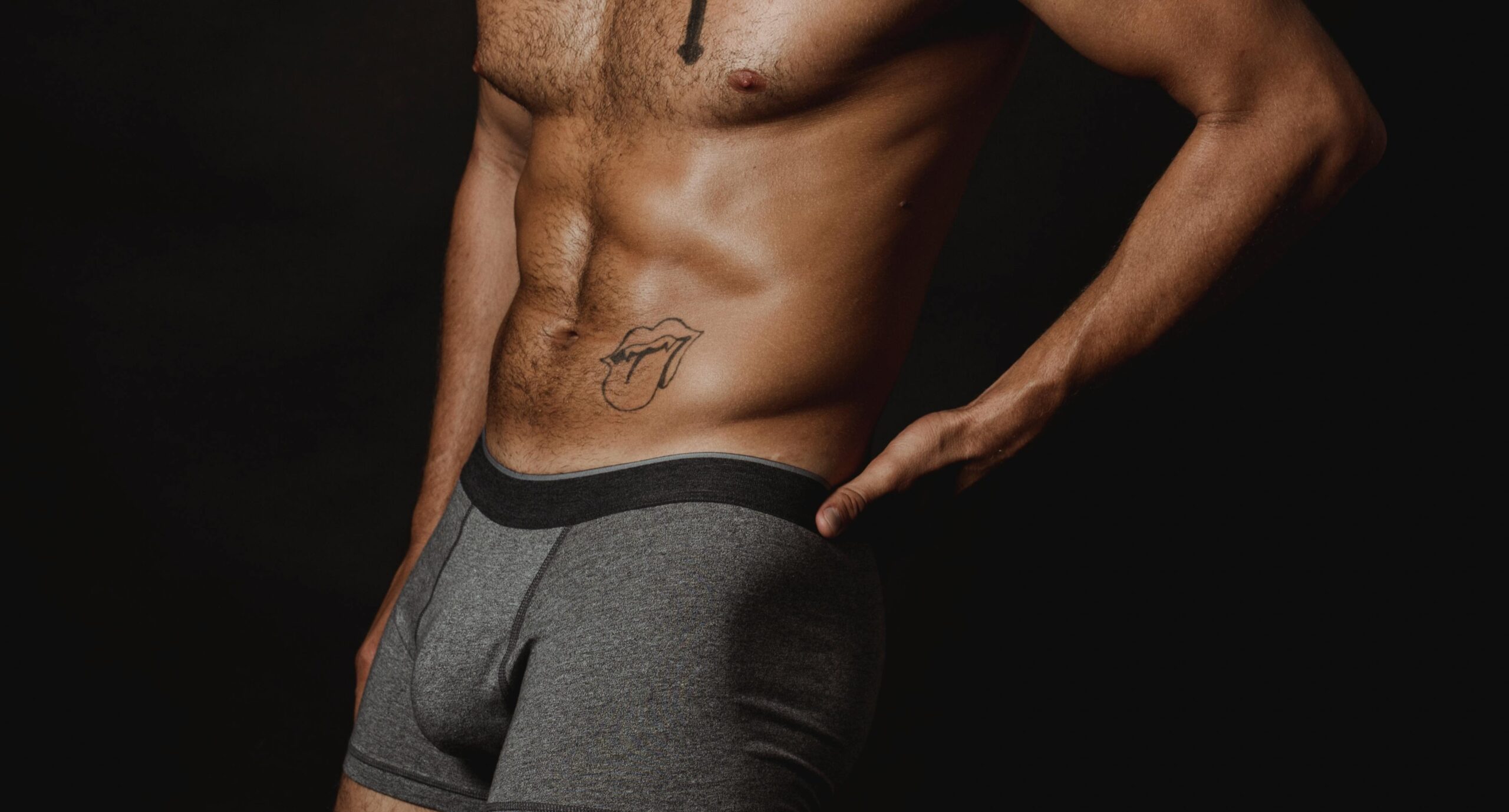Hi! I’m Dallas Knoxxx, your go-to guy for all things wild and straight-up real.
I’m 27, reside in West Hollywood, and get to live out my sexual fantasies every day. I’ve starred in a studio scene (go check it out) and have an OnlyFans (I’m also on Twitter!) I’m constantly posting and spending nights cruising and hooking up in the city of angels.
I’m also obsessed with feeling hot and sexy in a pair of naughty knickers, so if you’re one of the people who loved my best gay jockstraps to wear article, you’ll love it as I dig deep into the philosophical question that has haunted humankind for eons: boxers or briefs??
Choosing a pair of underwear can be tricky if you’re like me. We wear certain fabrics, styles, or brands; everyone is different. Underwear choices intersect with varying criteria like fashion, body image, and sexuality.
We will get into it all, but first, we gotta understand how we got here.
What’s better or more affordable? How does gay culture play a role in shaping and popularizing sexier, more body-conscious underwear? Let’s jump right in.
A brief history of briefs, underwear, and boxer shorts
First, it’s essential to understand why we have what we have today. Boxer shorts were invented in the 1920s for boxers (like fighters) by Jacob Golomb, founder of Everlast, the brand that makes punching bags and stuff.
These boxer shorts were designed to help athletes have more mobility in their legs with less restriction; about fifteen years later came the brief, which came about from Arthur Kneibler, founder of Jockey. After Kneibler saw a swimsuit ad, he created underwear and an underwear design that mimicked the form-fitting shape of what we now know as briefs.
The design at the time was revolutionary. Compared to boxers, briefs added more support and versatility, and soon, brands like Jockey, Hanes, and Fruit of the Loom dominated the market.
How do I choose boxers or briefs for myself?
Boxers or briefs are a personal preference. Nonetheless, there is a lot of influence in everyday life around you to like certain brands and types of underwear, especially in the gay community. Don’t you remember being a kid in Boscov’s, aimlessly wandering down the men’s underwear aisle while your mom wondered where you went?
I started as a boxer girl simply because it was affordable and comfortable. Being a bigger kid, the boxer was more agreeable with my body image. As time passed and I got older and a little skinnier, I started moving on to tighter, more form-fitting underwear, mainly for the look and popularity in my culture.
Whether you realize it or not, celebrity endorsement ads have greatly impacted me, which opened me up to the world of underwear. The first one that comes to mind is Justin Bieber with Calvin Klein. I think the ads were definitely for the girls and the gays, and underwear endorsements are a great way to suck gays into buying with a hot bod, and the women who may be buying for their husbands with some eye candy for themselves.
After briefs held in court for several years, they found a way to conquer the space by using celebrities in their prime to endorse their products, and that’s just what happened. Every other gay boy and I went out and bought the tight, soft, and popular underwear everyone was wearing and sporting in their everyday photos.
Your sexuality also plays a massive role in the types of underwear you like. In the past, for the straight community, men typically go for the loose-fitting look—not because they don’t care, but because they aren’t concerned if their ass looks good in their undies.
The gay community, on the other hand, fixates on whether or not it’s showing what it needs to show. Gays are very sex-forward, and being able to give imprints and ass while feeling confident in your underwear is a must.
Nowadays, from some casual polling I’ve conducted, I’ve noticed that sexuality is finding its way out of the equation. Men of any orientation are starting to gear more towards a tight, form-fitting pair of underwear versus a loose, flappy boxer. However, it still depends on the type of guy. In the early 90s, numerous health magazines and news outlets reported that tight underwear causes fertility issues or a lower sperm count, and that certainly got some procreation-focused men’s attention.
As a result, tight and form-fitting underwear quickly became less popular, and boxers started making a comeback thanks to the popular brand Ralph Lauren creating an ad that showcased a male model stripping down to his white boxers in a laundromat, sending the gays on a craze.
While boxers once reigned supreme for their comfort and loose fit, recent years have shown a noticeable decline in popularity. What was once considered the go-to choice for men seeking breathability and simplicity has become less favorable, especially among younger generations and fashion-conscious individuals.
Why the shift from boxers to briefs again?
As clothing has become slimmer and more tailored, loose-fitting boxers can bunch up, ride awkwardly, and create visible lines. Form-fitting underwear like briefs, trunks, and boxer briefs offers a smoother silhouette that complements modern fashion trends.
Another reason for the decline is aesthetic appeal. Boxers often lack the intentional design and structure found in other styles. In an era where self-expression and sex appeal are front and center, particularly within queer spaces, boxers can feel outdated or overly conservative.
Social media, thirst traps, and influencer culture have helped glamorize more revealing and body-conscious options. Let’s be honest—when was the last time you saw someone in a Calvin Klein ad rocking a pair of classic plaid boxers?
Even comfort, boxers’ most significant selling point, is being challenged. New fabric technologies are used in snugger styles that still offer breathability without sacrificing support or fit.
As a result, boxers are starting to feel like a relic of a time when fashion and underwear lived in separate lanes.
That’s not to say boxers are obsolete, but they’ve lost their mainstream grip. Today, they live more in nostalgia, sleepwear, or a specific kind of retro vibe.
For the everyday look, most people are reaching for something a little tighter, a little sexier, and a lot more curated.
It will be awesome to see where we are going with undergarments in the future. Briefs have created many different styles and categories, like jockstraps or g-strings. We used to be unable to customize our underwear style, and now we have mesh, silk, cotton, and many more fabrics to choose from that fit us personally.
In past years, underwear was always based on functionality before style, and now we are moving on to an era that highlights style and fashion rather than versatility and functionality.
Wouldn’t it be easier to go commando most of the time? Confidence in underwear has also increased over the years due to ad campaigns that highlight plus-size models.
In the end, underwear has evolved far beyond its original purpose. What once started as a simple necessity reflects identity, confidence, and cultural expression. Whether it’s the classic cotton boxer, the sleek brief, or something more daring like a mesh thong or jockstrap, our choices are tied to how we see ourselves and want to be seen.
As conversations around gender, sexuality, and body image continue to evolve, so does the way we approach the most personal layer of clothing we wear. It’s not just about support or breathability—it’s about empowerment, comfort, and individual expression.
So, whether you choose briefs for how they hug your body or boxers for their easygoing freedom, wear what makes you feel good. Try new styles, challenge old habits, and don’t be afraid to treat underwear like the fashion statement it truly is. What’s underneath counts—and it’s for you, not anyone else.
I want to hear what you prefer, too! In the comments, let me know if you would rather wear commando, boxers, or briefs.



I like to check out the undies in the locker room. I prefer the standard 6″ leg for myself, as I am tall and slim. The well built guys, with thick thighs and round asses, look super hot in a trunk, as that length emphasizes their muscularity. I try to take my time getting changed, so I can stand around in my tight boxer briefs. And I always wear a hot jock or thong when I go to the bath house.